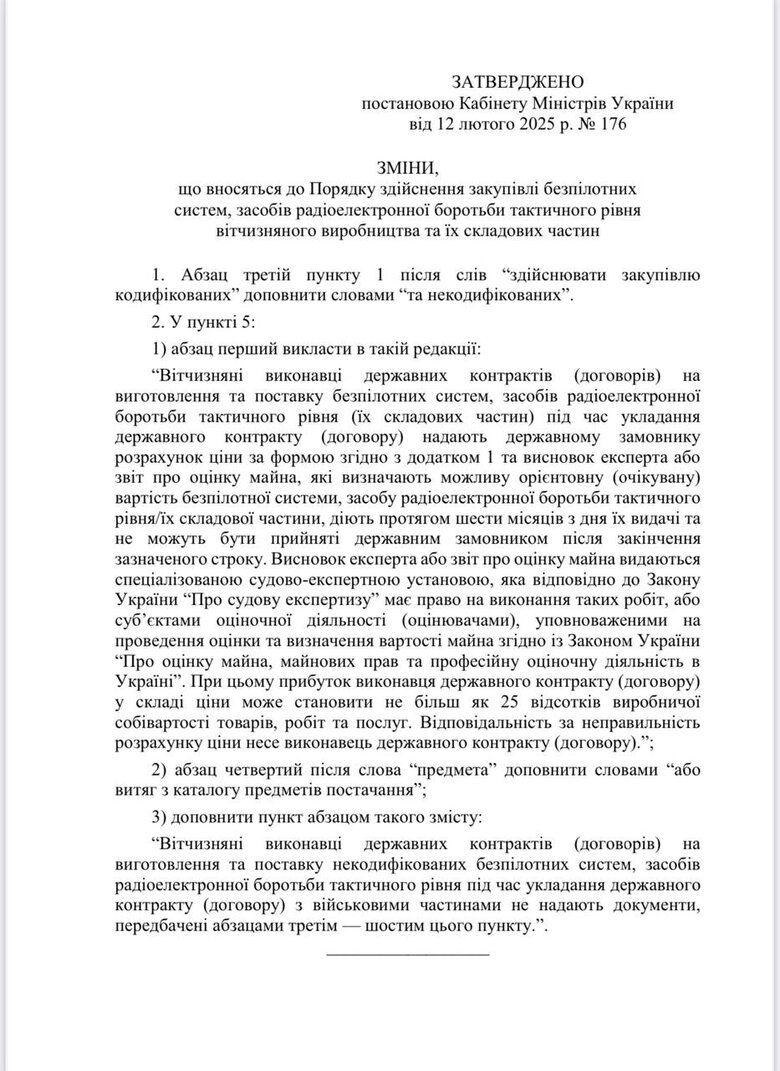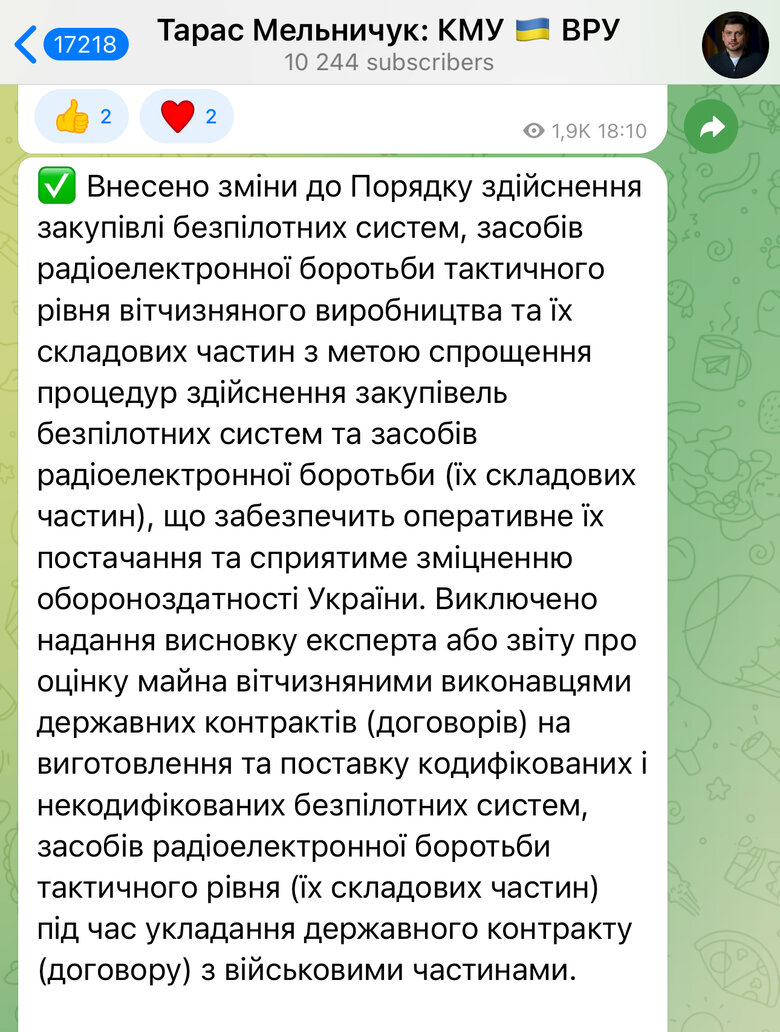Blocking supply of drones to military units: who is to blame and what has been done
It is becoming a bad tradition of the Cabinet of Ministers to adopt resolutions that are detrimental to the supply of the frontline. In 2023, this was the case with Resolution 335, which forgot to mention the word "profit", and after which some defence companies were threatened with criminal proceedings. At the end of 2024, the Cabinet of Ministers adopted Resolution 1450, which effectively blocked the procurement of drones and electronic warfare for military units.
Censor.NET investigated how this happened and why seven nannies have a child without an eye.
Defence procurement is governed by several regulations. The key ones include the Law on Defence Procurement, the Law on Public Procurement and Cabinet of Ministers Resolution 1275. The latter aims to simplify procedures and improve the quality of procurement. This decree is often rewritten.
In December 2024, it was amended by the SSSCIP, which changed the rules for the procurement of drones and EWs.
However, what was planned as a regulation of the market rules ultimately provoked a major slowdown, if not a halt, in the procurement of drones and electronic warfare systems by individual military units.
Resolution 1450 effectively ended the experiment in the procurement of drones, after which only codified products were to be procured, accompanied by the provision of a number of documents by the manufacturer-supplier.
By amending the resolution, the Cabinet of Ministers, upon the proposal of the SSSCIP, established new rules for the procurement of drones (unmanned systems) and electronic warfare.
From now on, the military will have to obtain a permit to purchase drones:
-price calculation;
-an expert opinion on the estimated cost of the product, which is valid for 6 months;
-a certificate that the supplier's profit does not exceed 25% of the production cost.
You also need to obtain one of the following documents from the supplier:
-a certificate of compliance with standards or specifications;
- a certificate of registration of a staffing item;
-a document on approval for operation;
-an act on joint departmental testing.
Let's look at what this means in practice using the example of obtaining a certificate of registration of a staffing item.
This requires codification, which takes place either based on the results of joint departmental tests or on the results of reviewing documents provided by a domestic manufacturer. The Ministry of Defence has ten working days for codification. That's two weeks. After the drone is codified, it is added to the staff and time sheets. After codification, it is necessary to obtain a certificate of registration for the staffing item, which will also have to wait. After all, neither the resolution nor a special order of the Ministry of Defence specifies the timeframe for issuing such a certificate.
Previously, military units in the field could quickly buy an uncodified drone or electronic warfare device, but now the market is limited to codified goods, which cost twice as much as uncodified ones.
"You have to stand in line for months to get them," say military unit buyers. Do they have time to wait? Obviously, this is only a matter of the number of Ukrainian soldiers killed.
But perhaps the biggest problem was obtaining an expert opinion on the value of the products. Since the number of certified experts is limited, the procedure takes 2 to 4 weeks and can cost up to UAH 70,000 for one opinion. If the equipment or minimum technical characteristics of the product are changed even partially (and in the case of individual units, this can be every extra antenna), the procedure has to be repeated, which means additional delays and costs.
The Kyiv Scientific Research Institute of Forensic Expertise and 20 other experts in the country can give an opinion.
In addition, the amendments to Resolution 1275 did not provide clear mechanisms for the procurement of spare parts and components. In addition to the drone system itself, the military needs additional equipment: batteries, antennas, boards, and ground control stations. And here you can spin it any way you want, because when a product is codified, there is no clear list of components, and it is virtually impossible to obtain an expert opinion on a single component.
As a result, procurement by military units has actually stagnated.
What does it look like in numbers? The Ministry of Defence transferred UAH 5 billion to military units in December and January. However, while these purchases of drones and electronic warfare devices were made quickly and without bureaucratic collapse before 24 December, starting from 24 December, purchases are made by about 30%.
The burden of "must-be-done yesterday" once again fell on the shoulders of volunteers.
Having realised the extent of the problem, the procurers of military units began to push the MoD to make changes. In principle, the MoD should have taken these risks into account at the stage of submitting the SSSCIP initiatives, but this did not happen.
"They didn't submit any comments at all," Censor.NET's sources say about the MoD's work at the preliminary stage.
"It's not true, we have demolished many harmful things," the Ministry of Defence is indignant.
One way or another, the result of blocking procurement was "on the scoreboard". The situation became public.
And last Friday, the Ministry of Defence submitted its amendments to the resolution to the Cabinet of Ministers.
But then it turned out that other amendments to the resolution had been proposed by the Ministry of Digital Transformation.
As the Ministry of Digital Transformation explained to Censor.NET, the amendments to the resolution were submitted after a meeting of the military at the President's Office, where they outlined the problem.
The meeting was attended by: The 20th Separate Regiment "K-2", 429th Regiment "Achilles", 427th Regiment "RAROG", 414th Brigade "Magyar's Birds", and the "Phoenix" Regiment ("Pomsta" Brigade).
The amendments to the resolution were submitted by the Ministry of Digital Transformation on 12 February and voted on on 21 February.
What did these changes bring?
"The document to confirm the codification is clearly defined - the supplier of a codified product can provide an extract from the catalogue of supplies, which eliminates uncertainty in the requirements," says Yevhen Silvestrov, an expert of the Defence Procurement Reform Project supported by the UK Special Adviser on Defence.
The second advantage, in Yevhen's opinion, is the simplified access of manufacturers to military procurement. Suppliers can now sell non-codified items without the need to provide one of the following documents: a certificate of conformity, a certificate of registration of a staffing item, a document of approval for operation, or an act of joint departmental testing.
The third advantage is the expansion of the circle of experts who provide opinions, which should speed up the process.
Despite this, the issue of procurement of components and spare parts (antennas, ground stations, goggles, batteries, propellers, etc.) remains unresolved.
They continue to be subject to general procurement rules requiring codification, a certificate of conformity or a joint departmental test act. This significantly complicates and delays procurement.
And the second is the preservation of the mandatory expert opinion for non-codified products.
Since the conclusion is as inconvenient as possible and slows down procurement for military units, the latest amendments to the resolution from the Ministry of Defence proposed to remove it from the list of requirements for decentralised procurement.
On Monday, the MoD and the Ministry of Digital Transformation discussed the amendments, and the parties seem to have reached an agreement.
The final amendments of the Ministry of Defence were as follows:
"Domestic executors of state contracts (agreements) for the manufacture and supply of codified and uncodified unmanned systems, tactical-level electronic warfare equipment (their components) when concluding a state contract (agreement) with military units shall only provide a price calculation in the form according to Annex 1, without providing an expert opinion or property valuation report, as well as documents provided for in paragraphs three to six of this clause, with a limitation on the amount of profit of the executor of the state contract (agreement), established in the first paragraph of this clause."
By lunchtime, the NACP had agreed on the text of the amendments, but around 3pm, it became clear that the Ministry of Digital Transformation was again against them.
However, at 18:00, Taras Melnychuk, a representative of the Verkhovna Rada in the Cabinet of Ministers, said that the expert opinion was still excluded from the list of documents that suppliers should provide for military units.
It seems as if the spoons were found. But the sediment remains. As well as the question of who finally included military units in the text of the resolution. After all, this idea cost our military too much.
Tetiana Nikolaienko, Censor. NET



